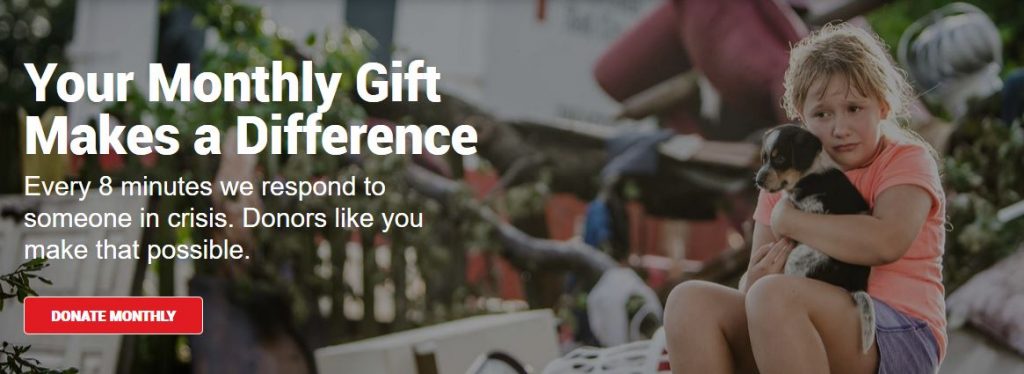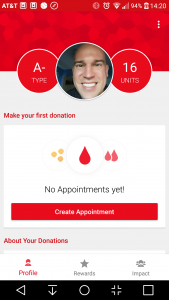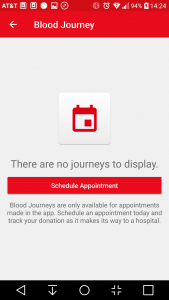At an overly basic level, there are two types of businesses. There are those that are designed to make a profit. And then there are those that are designed make a societal impact. Notwithstanding the movement in the Millennial generation to do both, the Red Cross is firmly in that charitable business category.
The Red Cross is an organization created to provide support to people who need it most. They provide life saving necessities to those who need it all around the world.
The American Red Cross prevents and alleviates human suffering in the face of emergencies by mobilizing the power of volunteers and the generosity of donors.
– Red Cross, Mission and Values
Because of population growth, continued global conflicts and natural disasters, the need for their efforts has never been greater. For proof, I give you Exhibit A and Exhibit B.
According to Exhibit B, $.91 out of every $1 goes towards actually helping people. Which is amazing when you consider the size of the organization. That is good enough to get it a B+ rating from Charity Watch.
Plus, on a purely selfish note, they give you cookies and snacks after you donate. I’ve never met anyone who can tell me with a straight face that they eat enough cookies…
So, with all of the great stuff in mind – the mission to advance social causes, the amount of people that they are able to help, and the cookies – I have to ask myself this question.
Why do I always feel bad when I leave there? Why don’t I feel like a million bucks for just having saved someone’s life? Instead, why do I leave there questioning why I went in to donate?
The Irritating side to dealing with the Red Cross
Through my many dealings with the Red Cross, I find that they often fail me, as a donor, with the social contract. And we will cover what social norms are below. But essentially, social norms is how the Red Cross “pays” you for your donation. They don’t do it with money, which is how employers typically entice their staff. What they are doing is asking you to donate your time and blood/platlettes/plasma as an act of charity.
Which make no mistake is perfectly fine. They are doing honorable work. They follow through on their mission. They have every right to ask people to help their mission out of their own free will. But because of their approach, they also come across as a “taker” to those who give. Let me elaborate on that point using three key points.
Point #1 – The constant calling for donations
Now, on one hand, this makes sense. See my point above about the rising need. However, based on the psyche of the donor, this can backfire. It can make the donor feel that what they give is never enough. And if the donor feels that nothing they can do will help, they begin to feel helpless. Helplessness breeds inaction.

Point #2 – Support the Supporters
As with any organization, the customer-facing team knowingly or unknowingly consistently promote a message from the organization. In my dealings with the the Red Cross, that message has often been one of feign interest. Which is amazing to me, because if I’m saving a life with a blood donation, how many lives must one of their nurses save a day? It has to be over twenty. Yet, when I see and interact with them, many don’t look energized. They don’t look excited to help.
Point #3 – The Pain of Donating
I’m not talking here about the needle prick. The pain I’m talking about here is the barrier of donation. One of the key factors in that barrier is the length of time the donation takes. Which, in fairness, the Red Cross has attempted to address recently.
The Red Cross rolled out “RapidPass” which will allow a donor to check in and answer the upfront question an day in advance. Yet, they aren’t reviewed until you get there. And it may save you 15 minutes of answering questions when you arrive, but it still takes anywhere from 15-45 minutes to start the donation.
The goal has to be to get people in and out as quickly and efficiently as possible. And that’s good for both sides of the equation. For the organization, they can get more donations per day. For the donors, they are asked to give less – making more people willing to donate based on the results from research by Indranil Goswami and Oleg Urminsky.
Business Takeaways
As part of our work with companies adopting the InnoSpecting Framework, we talk about rewarding employees and teammates for their contributions. And we stress that not only does it not have to be in the form of business norms (i.e. money), but it shouldn’t be in the form of business norms.
Social norms have been proven to be more powerful motivators than business norms – such as paychecks and bonuses. In Chapter 2 of his book Culture Trumps Everything, Dr. Gustavo Grodnitzky talks about applying social norms and how they can be powerful motivators after an employees basic needs have been met.
If businesses can make people feel that they are doing a job with meaning, a real mission, a purpose, or a cause, then they are applying social norms. Let employees know that they are doing a job that has a real impact on the world. We must honor employees, not only for a job well done, but also for their contributions to the organization and to society. This takes an inspirational, cause-drive culture. – Culture Trumps Everything, Dr. Gustavo Grodnitzky
And that is backed up by other recent studies, including this quote pulled from researched completed by Cone Communications and summarized in a quote below from an article first appearing on Sustainable Brands.
Three-quarters (76 percent) of Millennials consider a company’s social and environmental commitments when deciding where to work and nearly two-thirds (64 percent) won’t take a job if a potential employer doesn’t have strong corporate social responsibility (CSR) practices, according to the 2016 Cone Communications Millennial Employee Engagement Study
– Sustainable Brands, “3/4 of Millennials Would Take a Pay Cut to Work for a Socially Responsible Company”
Ways to Improve the Red Cross
As the Red Cross, I would use social norms to address the three identified points above. To address point #1 above, I would flip the script. Instead of asking for help and risk having the recruiters come across as desperate, I would remind people that they are eligible to help again and to focus on the good they have already done. It is less of a “thanks for your help, but we always need more…” and more of a “you saved three lives last time, 15 lives total, now are you ready to help some more?”

The interesting thing is, they are starting to move in this direction…to an extent. The image to the right is a capture of the homepage of my donor app, and it shows that I have donated 16 units to date. However, what good did I do with 16 units? I don’t know. Maybe it takes 50 units to save a person’s life — or maybe I just saved my one-hundredth life with my 16th unit. I would like to see that in tangible terms that would make me feel good about my donation.
Below is is the “Blood Journey” section of my app, which currently doesn’t show anything because I didn’t schedule an appointment through the app. When I donate, there are barcodes on EVERYTHING. They clearly track where the blood came from and where it was going, so why can’t I put a face and a name with the person I’m helping just because I didn’t book through the app? Can you imagine how powerful of a message it would be if the donor got a direct message thanking them for their donation from the person they helped?
There are social norms that can be applied to address the lack of enthusiasm from the support staff too.

Even though the nurses and receptionists are getting paid, in my opinion, this comes down to a social contract for them as well. Red Cross nurses will never make what surgical nurses do, or what nurses in well-funded hospitals can.
But, they still saves lives. And they need to be reminded every day of the life saving work they are doing. At the end of each day, they need to be told exactly how many lives they just saved. And they need to be challenged the next day to go save more.
I would have a giant scoreboard, and with ever donation I would add a number to the board. And I would make a show of that similar to a bartender ringing a bell when they got a good time. And next to today’s “score,” I would have the all time records for both that specific unit and the Red Cross holistically. I would challenge them each and every day to save more lives than they did the day before and I would find a way to celebrate every life they saved.
I would also start looking for ways to generate greater awareness for all the great things the Red Cross support staff and donors are already doing. Right now, their social media posts a lot of great stories about the families they help, but rarely do they highlight who is doing the helping or how much they are helping. For instance, the image below is a tweet pulled directly from their Twitter feed.
Rachelle is working her way through school. Has a job as a secretary. Volunteers in whatever free time she has. And yet, her image got 1 comment and 58 likes for International Women’s Day . Now, those would be great numbers for Ever Evolving’s social media following, considering we only have 131 followers at the time of this writing. However, the Red Cross has 5.42 MILLION. It is great to see that they are beginning to promote this; however, they clearly have work left to do. (NOTE: at the time this post was released, Rachelle had received 1 comment and 70 likes. Still NOT NEARLY ENOUGH for someone so impressive!)

And I never saw any promotions of donors. While I understand that donors would need to consent to having their name and image used, the Red Cross should be actively looking for success stories to share there as well. When donors hit milestones, they should be publicly celebrated. Use the fact that Jane Smith (fictional person for sample purposes) just donated her 100th pint of blood, in the process saving over 225 lives over 16 years to get other people willing and interested in donating!
Finally, the Red Cross needs to continue to experiment (and evolve) how they capture their donations to make the process as seamless and simple as possible. While I am more than willing to donate to help people, my time is still important. While I understand that there are a lot of safety precautions in place to keep people safe and make sure there are no mix-ups, it doesn’t mean that the donors will be anymore understanding of long wait times.
It reminds me of the phone markets back a decade ago. Blackberry was the dominate phone on every network. They offered email, SMS, direct messages, security, and they did it all without killing the Network’s bandwidth. Then the iPhone came out. It cared less about security. It didn’t care at all about bandwidth. But its User Experience (UX) was unparalleled at that time. What happened next? People flocked from Verizon to AT&T because they were the only network carrying the new technical marvel.
The Red Cross needs to take a lesson from Blackberry and continue to push its boundaries. Although for now they are the biggest game in town, it still needs to be constantly looking for ways to lower the barrier of donation. As a donor, I become very aware of all I’m giving up to be there when I’m just sitting in a waiting room. And if they aren’t careful, when a new player comes by offering a better experience, I’ll be ready to jump ship.
This is where the InnoSpecting Framework and tools like our InnoSpecting Framework Management Tool can help out. We use these things to coach organizations on how to take new ideas, and methodically experiment with and implement the ideas the provide the greatest organization value. We designed our framework specifically to prevent companies like Blackberry from losing its market lead, to help second-tier players challenge market leaders, and to help optimize organizations like the Red Cross so they can prevent and alleviate global human suffering.
Make the Red Cross Great Again
OK, admittedly, this is a stretch. The Red Cross is currently a great organization. However, if their mission is to prevent and alleviate suffering, it is time to consider a few strategic tweaks to their business model. And this is not something that is uncommon for organizations. Given the fact that the Red Cross was founded over 130 years ago, my guess is they have probably already overhauled their business model a time or two.
Still, this is the type of work that Ever Evolving helps organizations with. If you feel like your organization is beginning to feel stale, and could use a new approach to innovation, schedule a time to meet with our experts by booking an appointment. Initial appointments are kept to less than thirty minutes, and are conversational in nature. These conversations are designed to simply determine IF we MAY be a good fit to work together.
UPDATE: I gave blood again yesterday at a Red Cross blood drive. I got there at 2:25pm – about 25 minutes AFTER my appointment was scheduled to begin. I left at 3:41pm. Lets take away 10 minutes for their delicious snacks at the end, and the 10 minute penalty I endured for being late to my appointment (which is fair). So that means I was there for 56 minutes. I had not filled out the RapidPass, so I had to do that there. So, lets subtract another 6 minutes for that (it did not take that long, but it gets us to an even number). That’s 50 minutes. The actual collection of my blood took 4 minutes and 19 seconds. That means that less than 1/10th of the time I was there I was giving blood. That, in a nutshell, is what is frustrating about dealing with the Red Cross.
Also, still, no word on how many lives I’ve saved…